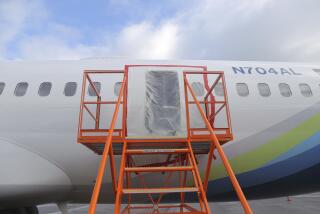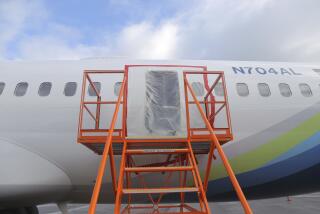TWA Recordings Show No Hint of Disaster
- Share via
BALTIMORE — The cockpit crew apparently had no inkling of impending disaster in the moments before a center fuel tank explosion tore a TWA jumbo jet apart last year off Long Island, N.Y., cockpit voice recordings show.
Pilot Ralph Kevorkian and co-pilot Steven Snyder were conversing normally as TWA Flight 800 climbed after an uneventful takeoff at 8:19 p.m. on July 17, 1996, from New York’s John F. Kennedy International Airport, according to transcripts of the recordings made public Monday during the opening session of weeklong National Transportation Safety Board hearings on the crash.
“Thirteen thousand. Stop the climb at one-three thousand,” Kevorkian responded at 8:26 to an air traffic controller’s routine instruction to level off momentarily.
“Twelve [thousand] for thirteen,” Snyder confirmed.
Kevorkian scanned his instruments.
“Look at that crazy fuel flow indicator there,” Kevorkian said, noting a frequently malfunctioning Boeing 747 gauge that NTSB investigators say posed no problem and had nothing to do with the crash.
“See that,” Snyder answered.
Controllers told Flight 800 to climb 2,000 feet higher. Kevorkian asked his flight engineer, Oliver Krick, to power up the engines for the resumed climb.
“Power’s set,” Krick answered.
Thirty-seven seconds later, with no warning of any kind, the sound of the exploding fuel tank was picked up by a cockpit microphone, NTSB investigators say. A fraction of a second after that, the recorder went dead.
NTSB investigators say that the blast probably was touched off by static electricity or some mechanical breakdown that generated a spark--not by a bomb or a missile, as some initially hypothesized. That message was hammered home repeatedly on Monday.
An animation screened during the morning showed dramatically what the NTSB believes happened after the blast. The animation was, in many respects, similar to one shown a few weeks ago by the FBI, when that agency concluded officially that the downing of Flight 800 was not a criminal act.
Working from evidence gleaned from radar data and from the tons of shattered wreckage recovered from the sea, the NTSB has concluded that the blast tore off the cockpit and passenger section ahead of the fuel tank, at the point where the wings join the fuselage.
The NTSB animation shows that with this forward section gone, the flaming remainder of the jumbo jet--the wings, engines, tail and most of the fuselage--continued to fly for several seconds, banking left in a climb to about 15,000 feet before rolling over to the right and plummeting nose down toward the ocean.
This may account for the reports from witnesses who thought they saw a missile streak across the sky. The animation shows that, as viewed from the ground, the burning main section looked a lot like a rocket as it climbed and then plunged.
Shortly after 8:32 p.m.--55 seconds after the fuel tank explosion--this main section of the plane hit the water, followed about 40 seconds later by the nose section.
Investigators said the nose hit later because it was lighter and had more wind resistance.
All 230 aboard Flight 800 were killed. Medical experts testified Monday that all of them probably were knocked unconscious by the initial blast. Most of them died of injuries that killed them instantly, but it is not certain at what point those injuries were sustained.
Dr. Dennis Shanahan, a retired Army physician who is an expert on war wounds, testified Monday that none of the victims’ injuries appeared to have been caused by a bomb or a missile.
“We looked for any evidence of an explosive device,” Shanahan said. “We found none.”
Jim Wildey, an NTSB expert in determining the mechanical stresses suffered by airplanes in a crash, said he found no evidence that a bomb or missile downed Flight 800.
Richard Bott, a warhead-impact expert who works at the naval air station in China Lake, said that in studying the damage patterns on the Flight 800 wreckage for months, he has “seen nothing” to support the missile and bomb theories.
Barrie Shabel, a retired Alcoa metallurgist, said he found no evidence of the sorts of deformations and fractures that would have been caused by a bomb or missile.
But there was one voice of dissent.
Moments before NTSB Chairman Jim Hall called Monday’s meeting to order, a protester from the Socialist Workers World newspaper in New York City ascended the dais to call the hearings a fraud and demand an independent investigation of the missile theory.
The unidentified man was escorted from the room.
Hall asked if anyone else planned to offer an unsolicited opinion. No one did.
More to Read
Sign up for Essential California
The most important California stories and recommendations in your inbox every morning.
You may occasionally receive promotional content from the Los Angeles Times.










